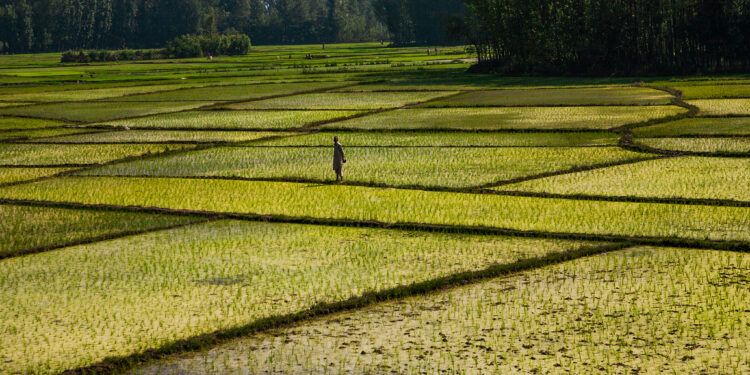Pakistan is the third-largest consumer of groundwater after India and the United States, accounting for nearly 9% of worldwide groundwater withdrawals. Due to these massive withdrawals, Iran is now one of the few nations whose groundwater withdrawals are greater than the pace at which aquifers naturally replenish themselves. As a result, the availability of groundwater is quickly diminishing, endangering the sustainability of this priceless natural resource.
Worryingly, Pakistan is one of the top exporters of groundwater in the world because of its high extraction rates, which are mostly used for agricultural irrigation. Exports of agricultural products, particularly those of rice and sugar, cause it to lose a significant amount of water.
Pakistan indirectly sells 5,000 liters of embedded water with every kilogram of rice it exports, water that will no longer be accessible for the nation’s residential, industrial, or drinking needs. Such embedded (hidden/virtual) water, which is present in products, particularly agro-foods, has several significant ramifications for the nation’s social and economic development. However, these have not been detected thus far.
In a society that is getting more globalized, water is becoming more and more crucial. Many analysts predict that future conflicts will be fought over water. After coming to this realization, several nations decided to adopt a strategy of outsourcing water-intensive products to other nations. They are now including “water conservation via global trade” in their long-term plans.
In agriculture, they export high-value, less water-intensive crops while importing those that require a lot of water. With the help of such a strategy, nations may manage their rising water needs while preserving water for future generations.
Given the new international trade environment, Pakistan has to reconsider its long-term export strategy from the perspective of groundwater export, particularly given that it has developed into a water-intensive economy in the world. Due to poor irrigation efficiency and a larger reliance on water-intensive industries like agriculture, textiles, and leather, it has the greatest water consumption per unit of GDP in the world.
Pakistan obtains groundwater from the Indus Basin aquifer, which is now the second most stressed aquifer in the world, according to a National Aeronautics and Space Administration (Nasa) assessment, making the situation concerning.
Unquestionably, our agro-food exports help us to balance our trade and generate much-needed foreign currency, but they also have significant negative social and environmental effects on both rural and urban populations. Despite the enormous amount of water lost as a result of exports, little attention is paid to identifying water footprints or accounting for water loss.
The groundwater table is fast dropping as a result of excessive pumping and a lack of groundwater replenishment techniques. In general, a lower water table causes the water quality to degrade as a result of saltwater intrusion, which harms both the local population’s access to clean drinking water and the health of the land.
More energy (electricity and fuel) is needed to pump water out of the earth due to the drop in the water table. It raises the expense of both irrigation and the nation’s imports of oil, gas, and coal. Additionally, it makes the issue caused by climate change worse.
Rapid groundwater depletion is a complicated problem that calls for multifaceted approaches on several fronts. Farm-level initiatives, however, can greatly lessen the severity of the problem. These consist of the: Crop rotation aims at reducing the weight of water-intensive agro-food in the total exports of the nation. increasing the effectiveness of irrigation in Pakistan’s agricultural sector, which uses more than 90% of the country’s water. Recharging groundwater artificially
Unfortunately, Pakistan’s export base is relatively small and there are not many things that can be exported. The major food export from the nation is rice.
Additionally, considerable amounts of sugarcane molasses, potato, onion, dates, mango, citrus, sesame, and maize were exported in 2021–2022. In addition, Pakistan exported six million tonnes of sugar produced from the sugarcane harvest between 2011 and 2020.
The two crops that need the most water are those cultivated on 3.34 million and 1.165 million hectares, respectively: rice and sugarcane. According to one of the studies, rice, sugarcane, and wheat account for over 80% of all groundwater withdrawals in Punjab.
On the other hand, either totally or partially, groundwater is used to irrigate over 76 percent of Punjab’s farmed land (augmenting surface water). Because of the rising lack of canal water brought on by climate change and the declining capacity of dams, groundwater withdrawals are projected to continue to rise in the future.
While fully stopping or reducing rice and sugar exports in the short future will be utopian and impossible, there is a need to find other exportable crops with minimal water needs. To the degree that Pakistan develops these crops primarily to satisfy local rice and sugar demands, such crops can partially replace rice and sugarcane regions.
Due to low irrigation efficiency brought on by farmers’ lack of knowledge and skills and their inability to afford high-efficiency irrigation technologies, Pakistan’s agriculture industry utilizes more water than its peer countries for the same amount of produce. Additionally, the discounted rate for agricultural tubewells has led to an increase in the indiscriminate pumping of groundwater.
It is imperative to increase irrigation efficiency, particularly for rice and sugarcane crops, using tried-and-true technology that has produced notable results in nations that are similar to our own.
We can implement artificial groundwater recharge technology at the farm level that can assist raise the water table and address the problem of drainage of surplus precipitation in farms by learning from the experience and success stories of other nations.
It appears that policy tools focused on regulation and police may not be able to resolve the problem of indiscriminate groundwater pumping given the existing sociocultural setting of rural parts of the nation. Financial inducements for farmers, however, can successfully lower withdrawals (abstraction) to a level at least equivalent to the recharge rate that can guarantee the sustainability of groundwater.
















